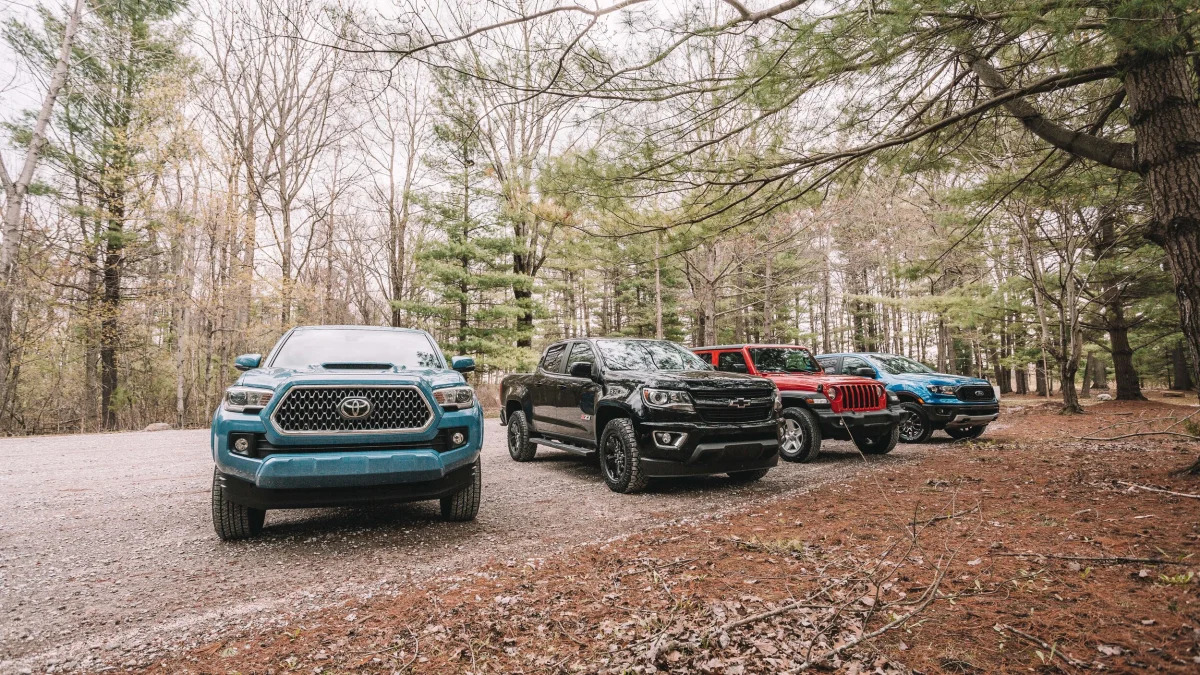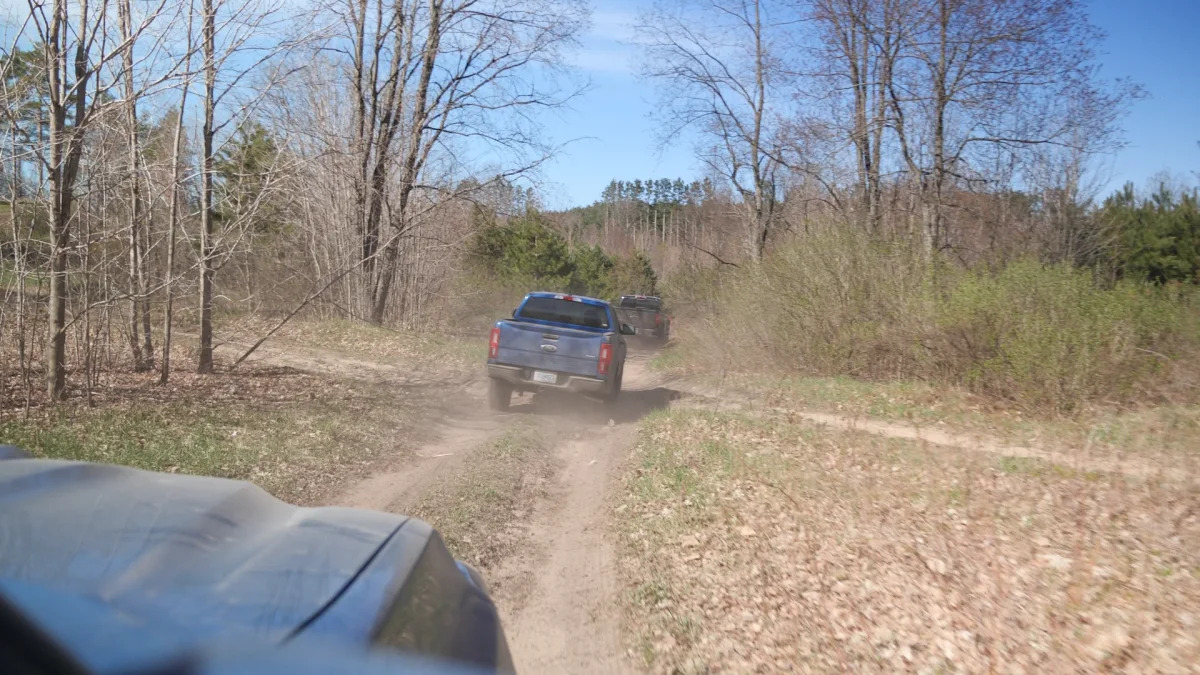2019 Nissan Frontier Review
Though it dates back to 2005, the 2019 Nissan Frontier remains a competent pickup truck with a serious value proposition. It has comparable performance to newer competition with an all-around pleasant driving demeanor. It’s also the most compact of the current crop of midsize trucks, making it about the easiest to maneuver. And for manual transmission die-hards, the Frontier is one of only two trucks that still offers a transmission with a clutch pedal, the other being the Toyota Tacoma.
But if you’re not worried about size, cost or the availability of a manual transmission, there are other trucks that offer more. The Honda Ridgeline is the most carlike and refined midsize truck available, the Ford Ranger offers impressive power and is good enough all around to win our latest truck comparison. The Chevy Colorado and Jeep Gladiator offer impressive off-road capabilities. The next-generation Nissan Frontier, which is reportedly going to be revealed next year, may close some of those gaps. In the meantime, we expect the current truck to stick around for a while, possibly well into 2020, so if a simple little truck for not too much money is all you need, give the Frontier a close look.
What's new for 2019?
There’s only one change for the 2019 Nissan Frontier and that’s the standard fitment of a 7-inch touchscreen infotainment system on every model, including the bare-bones S trim. It replaces a 5-inch non-touchscreen infotainment display included in 2018 models. It’s only included with Frontiers that don’t have navigation, though. Selecting navigation nets you the smaller 5.8-inch touchscreen display.
What's the Frontier's interior and in-car technology like?
One of the two areas the Frontier’s age really shows is with the interior, which apart from feature content, really hasn't changed much in 14 years. The dashboard, while attractive enough with its simple, rugged shape, features loads of hard, shiny, cheap plastic. The same goes for the door panels and center console. The competition has moved to much higher quality materials.
The gauge cluster is a time machine, with simple dials and a digital odometer and trip computer that only show miles traveled. You can forget about miles to empty, driver assistance displays and anything that would need a high-resolution screen. The infotainment system is also dated. Models without navigation get a 7-inch touchscreen, while navigation-equipped Frontiers get a smaller 5.8-inch touchscreen. Both systems use a clunky interface with relatively low-resolution graphics, and neither is available with Apple CarPlay or Android Auto. They do at least come standard with USB and Bluetooth connectivity.
How big is the Frontier?
From the outside, the Frontier is the smallest of small trucks. Its shortest variant is about 5 inches shorter than the next smallest Ford Ranger. And its longest variant, which combines a four-door crew cab with the extended cab’s longer bed, is only an inch longer than the Jeep Gladiator, which gets a shortened crew cab bed. The short and long beds aren’t really any smaller than the competition, though, with dimensions varying by an inch or two for and against the Frontier’s favor. This makes the Frontier quite easy to maneuver in town, while not giving up anything in the way of cargo hauling. Also useful is the fact that the bedsides are very low, making it a breeze to reach in to place or grab items.
The Frontier’s cabin is also plenty spacious. Front seat passengers have plenty of leg, head, shoulder and knee room. The seats are well padded, though flat. A comfortable seating position is reasonably easy to find, but the steering wheel only tilts and telescoping is not available. In the four-door Frontier Crew Cab, the rear seats feature plenty of head and knee room as well, and the seat backs aren’t too terribly upright, so even on longer trips it’s a fine place to be. The rear seats in the Frontier King Cab, like in other extended cab trucks in this segment, are virtually useless except for the smallest children who should be in a child seat anyway. There are at least child seat anchors back there.
What's the Frontier's performance and fuel economy?
The base engine offered in the Nissan Frontier is a naturally aspirated 2.5-liter four-cylinder making 152 horsepower and 171 pound-feet of torque. It’s available with either five-speed manual or automatic transmission. It can only be had with two-wheel drive, whereas competitors such as the Toyota Tacoma and Chevy Colorado still offer four-wheel drive with their four-cylinder options. The manual, four-cylinder, two-wheel-drive Frontier is also the most frugal version of the truck with 19 mpg in the city, 23 on the highway, and 21 combined. Adding an automatic drops it to 17/22/19.
The optional 4.0-liter V6 makes 261 horsepower and 281 pound-feet of torque and comes with either a six-speed manual or five-speed automatic transmission. This engine can be had with either two-wheel drive or four-wheel drive. The two-wheel-drive V6 Frontier gets 16 mpg in town, 23 on the highway and 19 combined with the automatic, while the manual is effectively the same. The four-wheel-drive manual V6 Frontier drops to 16/21/18, and the automatic dips further to 15/21/17.
What's the Frontier like to drive?
The four-cylinder Frontier is quite slow, and you’ll be flooring it at every single on-ramp to keep up. Merging will require a bit more forethought, too. We had the opportunity to try one with a manual transmission, which helps you make the most of what little power the truck has. It’s an easy transmission to get used to since the clutch is progressive and feelsome. The shifter itself is notchy with long throws, though. The engine isn’t particularly smooth, but Nissan has insulated it from the cabin well, so it isn’t particularly loud.
The V6 improves on acceleration substantially over the four-cylinder, though it still doesn’t feel as quick as the Ranger’s turbocharged four-cylinder or the Colorado’s V6. The Frontier’s V6 is also a bit smoother than the base four-cylinder, and it’s just as well isolated, keeping the cabin quiet. Our experience has been with the automatic version, and despite having such an old five-speed, the transmission works fairly well. It shifts smoothly, and it chooses gears well without any hunting. Shifting speed isn’t fast but certainly tolerable.
No matter the powertrain, the Frontier offers a rather refined driving experience. The cabin is as quiet as its newer competition with only a bit of engine noise under hard acceleration. The ride is mostly smooth, even in the off-road oriented Pro-4X model we tried out. Only particularly large bumps yield much bouncing and kicking. The body feels fairly stiff, too, preventing much shuddering and shaking. Going around corners, the Frontier has mild body roll and feels willing to turn. The slow-ratio steering means you’ll be having to crank the wheel quite a bit in tighter turns. Though slow, the steering is accurate and has quite good feel.
What more can I read about the Nissan Frontier and the competition?
Autoblog Midsize Truck Comparo | Toyota Tacoma, Ford Ranger, Chevy Colorado, Jeep Gladiator
We compare four of the leading midsize pickup trucks off-road and on-road to determine a winner in a very close competition.
2012 Nissan Frontier Crew Cab 4x4 Drive Review
One of our former writers spends some time driving the Frontier, showing that it was showing its age even eight years ago ... and that we were also still impressed with the driving dynamics.

What features are available and what's the Frontier's price?
The 2019 Nissan Frontier, in addition to being available with two different engines paired with manual or automatic transmissions as well as two-wheel or four-wheel drive, has a couple of cab and bed options. Nissan offers either an extended cab with two rear half-doors or a crew cab with four full-size doors. The extended cab is only available with the long bed, while the crew cab can be fitted with a standard short bed or the long bed.
The S trim is the base of the Frontier line, and it gives the truck the lowest base price of any midsize pickup at just $20,385. That’s the price for a two-wheel-drive, four-cylinder, manual transmission, extended cab model. Its equipment list is curious, as it does have standard air conditioning, cruise control, a USB port and Bluetooth connectivity, however, it also only has manual mirrors and windows, and no remote locking and unlocking. Those show up on the next-highest SV trim. No Frontier has a tilting steering wheel.
Multiple near-luxury niceties are added to the SL trim, but the Frontier doesn't offer the same multitude of other cushy upgrades as its competitors do. Of special note, though, is the Pro-4X off-road trim that features a locking rear differential, Bilstein off-road shocks and skid plates for the oil pan, fuel tank and transfer case. The Desert Runner has the Pro-4X’s Bilstein shocks and a limited-slip differential, but is two-wheel drive.
You can find a full breakdown of features, specs and local pricing for the 2019 Frontier here on Autoblog, but the MSRP for each trim level and its base body style/transmission/drivetrain combination is listed below with destination included.
Four-cylinder
- S (extended cab, manual, 2WD): $20,385
- SV (extended cab, automatic, 2WD): $25,255
Six-cylinder
- S (crew cab, manual, 2WD): $26,345
- SV (extended cab, automatic, 2WD): $27,015
- Desert Runner (extended cab, automatic, 2WD): $27,695
- Midnight Edition (crew cab, automatic, 2WD): $31,030
- Pro-4X (crew cab, manual, 4WD): $34,535
- SL (crew cab, automatic, 4WD): $35,405
What are Frontier's safety equipment and crash ratings?
All Nissan Frontiers come with front, side and curtain airbags, rearview camera, ABS and stability and traction control. That’s the extent of its safety features (basically, stuff that was available in 2005), whereas competitors offer modern accident-avoidance tech that includes automatic emergency braking, lane-departure and blind-spot warning systems and more.
In IIHS testing, the Frontier scored the highest “Good” rating for moderate overlap, side and roof impacts. In the more difficult small-overlap driver and passenger tests, it scored the second-lowest “Marginal” rating. The headlights received the lowest “Poor” rating. Head restraints and seats were rated the second-best “Acceptable” rating, and LATCH child seat anchor acces was rated “Marginal.” NHTSA gives the Frontier an overall safety rating of four stars. The frontal crash test rating is three stars, the side test rating is five stars, and roll-over testing is three stars for the two-wheel-drive version, and four stars for the four-wheel-drive variant.
Autoblog accepts vehicle loans from auto manufacturers with a tank of gas and sometimes insurance for the purpose of evaluation and editorial content. Like most of the auto news industry, we also sometimes accept travel, lodging and event access for vehicle drive and news coverage opportunities. Our opinions and criticism remain our own – we do not accept sponsored editorial.







































































































































































